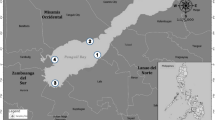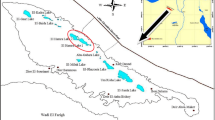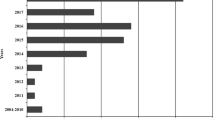Abstract
The concentrations of polar organic compounds including n-alkanoic acids, n-alkanols, steroids and triterpenoids were determined in extracts of shallow sediments from the Mesopotamian marshlands of Iraq. The sediments were collected by a stainless steel sediment corer, extracted with a dichloromethane and methanol mixture (3:1 v:v) by ultrasonic agitation and then analyzed by gas chromatography–mass spectrometric (GC–MS). The analysis results showed that the n-alkanoic acids ranged from C8 to C20 with concentrations of 7.8 ± 1.2 μg/g sample, whereas the concentrations of n-alkanols, which ranged from C12 to C39 were from 28.6 ± 4.3 to 121.7 ± 18.3 μg/g sample. The steroids and triterpenoids included stenols, stanols, stenones, stanones, tetrahymanol, tetrahymanone and extended ββ-hopanes. The total concentrations of steroids and triterpenoids ranged from 26.8 ± 4.1 to 174.6 ± 26.2 μg/g and from 0.74 ± 0.11 to 11.2 ± 1.7 μg/g sample, respectively. The major sources of these lipids were from natural vegetation, microbial (plankton) residues and bacteria in the sediments, with some contribution from anthropogenic sources (livestock, sewage and petroleum). Further studies of these wetlands are needed to characterize the input rate, transformation and diagenesis of the organic matter and to assess its various sources.







Similar content being viewed by others
References
Baraja-Aceves M, Hassan M, Tinoco R, Vazques-Duhalt R (2002) Effects of pollutants on the ergosterol content as indicator of fungal biomass. J Microbiol Methods 50:227–236
Barbier M, Tusseau D, Marty JC, Saliot A (1981) Sterols in aerosols, surface microlayer and subsurface water in the North-Eastern tropical Atlantic. Oceanol Acta 4:77–84
Barenholz Y (2002) Cholesterol and other membrane active sterols: from membrane evolution to “rafts”. Prog Lipid Res 41:1–5
Bode HB, Zeggel B, Silakowski B, Wenzel SC, Hans R, Müller R (2003) Steroid biosynthesis in prokaryotes: identification of myxobacterial steroids and cloning of the first bacteria 2,3(S)-oxidosqualene cyclase from the myxobacterium Stigmatella aurantiaca. Mol Microbiol 47:471–481
Brasington J (2002) The Iraqi marshlands: a human and environmental study. In: Nicholson E, Clark P (eds) Politics Publishing, London
Brassell SC, Eglinton G, Maxwell JR (1983) The geochemistry of terpenoids and steroids. Biochem Soc Trans 11:575–586
Charcosset JY, Chauvet E (2001) Effect of culture conditions on ergosterol as an indicator of biomass in the aquatic hyphomycetes. Appl Environ Microbiol 67:2051–2055
Chris M, Coakley J, Mayer T, Brown M, Thiessen L (2001) Application of fecal sterol ratios in sediments and effluents as source tracers. Water Qual Res J Can 36:781–792
Didyk BM, Simoneit BRT, Brassell SC, Eglinton G (1978) Organic geochemical indicators of palaeoenvironmental conditions of sedimentation. Nature 272:216–222
DouAbul A, Al-Saad H, Al-Timari A, Al-Rakabi H (1988) Tigris–Euphrates Delta: a major source of pesticides to the Shatt al-Arab River (Iraq). Arch Environ Contam Toxicol 17:405–418
Fernandes MB, Sicre M-A, Cardoso JN, Macedo SJ (1999) Sedimentary 4-desmethyl sterols and n-alkanols in an eutrophic urban estuary, Capibaribe River, Brazil. Sci Total Environ 231:1–16
Giner J-L, Boyer GL (1998) Sterols of the brown tide alga Aureococcus anophagefferens. Phytochemistry 48:475–477
Giner J-L, Li X (2001) Stereospecific synthesis of 24-propylcholesterol isolated from the Texas brown tide. Tetrahedron 56:9575–9580
Gülz P-G (1994) Epicuticular leaf waxes in the evolution of the plant kingdom. J Plant Physiol 143:453–464
Holz GG, Conner RL (1973) The composition, metabolism and role of lipids in Tetrahymena. In: Elliot AM (ed) Biology of Tetrahymena. Dowden, Hutchinson, Stroudsburg, pp 99–122
Kemp P, Lander DJ, Orpin CG (1984) The lipids of the rumen fungus Piromonas communis. J Gen Microbiol 130:27–37
Lawler A (2005) Reviving Iraq’s wetlands. Science 307:1186–1189
de Leeuw JW, Cox HC, Bass M, Peakman TM, van de Graaf, Bass JMA (1993) Relative stability of sedimentary rearranged sterenes as calculated by molecular mechanics: a key to unravel further steroid diagenesis. Org Geochem 20:1297–1302
Lehninger AL (1970) Biochemistry. The molecular basis of cell structure and functions. Worth Publishers Inc., New York, 833 pp
Mallory FB, Gorton JT, Conner RL (1963) The isolation of pentacyclic triterpenoid alcohol from a protozoan. J Am Chem Soc 85:1362–1363
Moreau RA, Whitaker BD, Kicks KB (2002) Phytosterols, phytostanols and their conjugates in foods: structural diversity, quantitative analysis, and health-promoting uses. Prog Lipid Res 41:457–500
Oros DR, Mazurek MA, Baham JE, Simoneit BRT (2002) Organic tracers from wild fire residues in soils and rain/river wash-out. Water Air Soil Pollut 137:203–233
Ourisson G, Albrecht P, Rohmer M (1979) The hopanoids: palaeochemistry and biochemistry of a group of natural products. Pure Appl Chem 51:709–729
Partow H (2001) Demise of an ecosystem: the disappearance of the Mesopotamian marshlands. United Nations Environment Program (UNEP). Publication UNEP/DEWA/TR. 01–3, Nairobi, Kenya
Philp RP (1985) Fossil fuel biomarkers: applications and spectra. Elsevier, Amsterdam, 296 pp
Richardson CJ, Reiss P, Hussain NA, Alwash AJ, Pool DJ (2005) The restoration of potential of the Mesopotamian marshes of Iraq. Science 307:1307–1311
Robinson N, Eglinton G, Brassell SC, Cranwell PA (1984) Dinoflagellate origin for sedimentary 4α-methylsteroids and 5α(H)-stanols. Nature 308:439–442
Rogge WF, Medeiros PM, Simoneit BRT (2006) Organic marker compounds for soil and fugitive dust from open lot dairies and cattle feedlots. Atmos Environ 40:27–49
Rushdi AI, Al-Mutlaq K, Simoneit BRT (2005) Sources of organic compounds in soil and sand particles during winter in the metropolitan area of Riyadh, Saudi Arabia. Arch Environ Contam Toxicol 49:457–470
Rushdi AI, DouAboul AA, Mohamed SS, Simoneit BRT (2006a) Distribution and sources of extractable organic matter in the Mesopotamian wetland marsh sediments of Iraq: I. Aliphatic lipids. Environ Geol (in press)
Rushdi AI, Al-Zarban S, Simoneit BRT (2006b) Chemical compositions and sources of organic matter in fine particles of soils and sands from the vicinity of Kuwait city. Environ Monit Assess (in press)
Salim SM (1962) Marsh dwellers of the Euphrates delta. University of London Press, London
Simoneit BRT (1977) Organic matter in eolian dusts over the Atlantic Ocean. Mar Chem 5:443–464
Simoneit BRT (1989) Organic matter of troposphere—V: application of molecular marker analysis to biogenic emissions into the troposphere for source reconciliations. J Atmos Chem 8:251–275
Simoneit BRT, Mazurek MA, Reed WE (1983) Characterization of organic matter in aerosols over rural sites: phytosterols. In: Bjorøy M et al (eds) Advances in organic geochemistry 1981. Wiley, Chichester, pp 355–361
Talling JF (1980) Water characteristics. In: Rzoska J (ed) Euphrates and Tigris, the Mesopotamian ecology and density. W. Jank, The Hague, 122 pp
Thesiger W (1985) The Marsh Arabs. Collins, London, 233 pp
Tulloch AP (1976) Chemistry of waxes of higher plants. In: Kolattukudy PE (ed) Chemistry and biochemistry of natural waxes. Elsevier, Amsterdam, pp 235–287
Venkatesan MI (1989) Tetrahymanol: its widespread occurrence and geochemical significance. Geochim Cosmochim Acta 53:3095–3101
Young G (1983) Return to the Marshes: life with the Marsh Arabs of Iraq. Hutchinson, London, 176 pp
Zander JM, Caspi E, Pandey GN, Mitra CR (1969) Presence of tetrahymanol in Oleandra wallichii. Phytochemistry 8:2265–2267
Acknowledgments
We extend our gratitude to Dr. Azzam Al-wash, Project Director, Eden, again for his support and encouragement. We thank the anonymous reviewers and the editor for their constructive comments, which improved the paper.
Author information
Authors and Affiliations
Corresponding author
Appendix: Chemical structures cited
Appendix: Chemical structures cited

Rights and permissions
About this article
Cite this article
Rushdi, A.I., DouAbul, A.A., Mohammed, S.S. et al. Compositions and sources of extractable organic matter in Mesopotamian marshland surface sediments of Iraq: II. Polar compounds. Environ Geol 50, 1171–1181 (2006). https://doi.org/10.1007/s00254-006-0289-y
Received:
Accepted:
Published:
Issue Date:
DOI: https://doi.org/10.1007/s00254-006-0289-y




